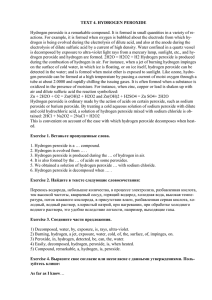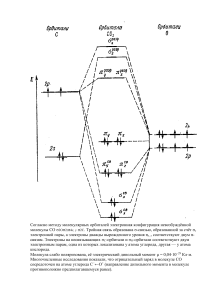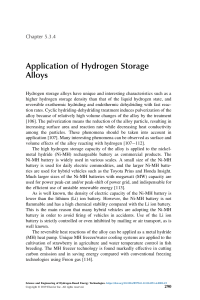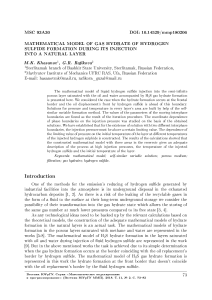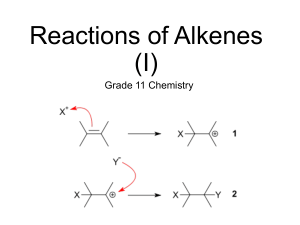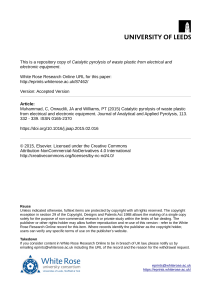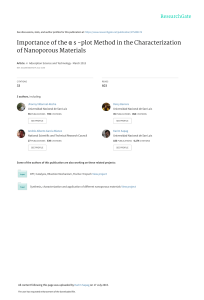Исследование возможности хранения водорода в природных
реклама
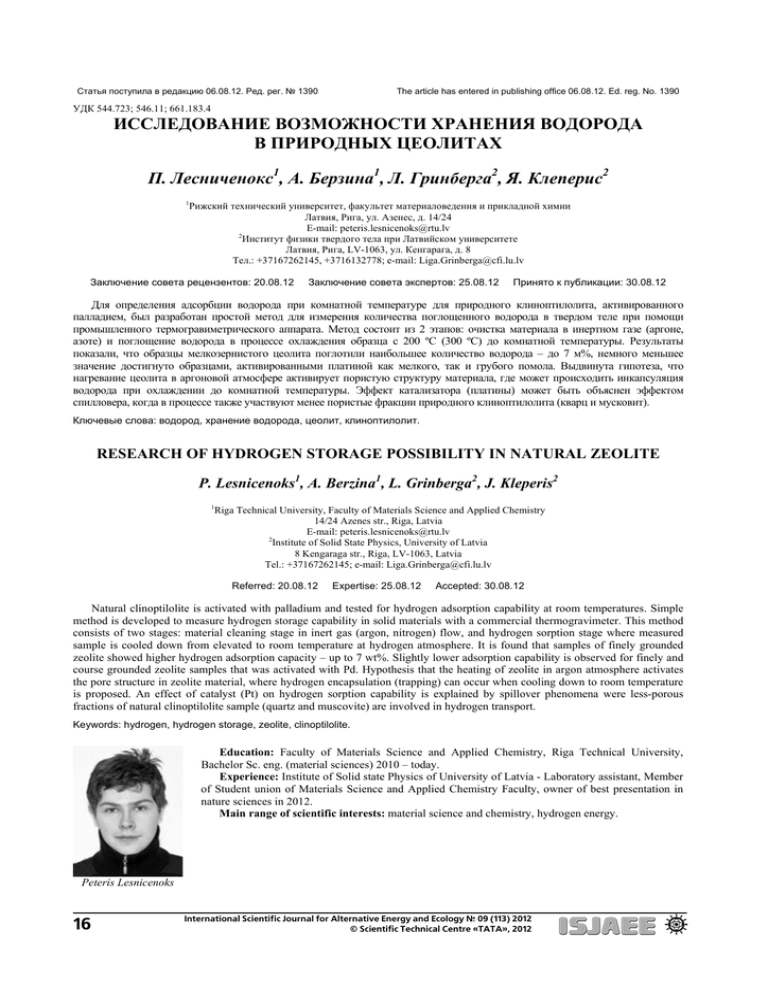
Статья поступила в редакцию 06.08.12. Ред. рег. № 1390 The article has entered in publishing office 06.08.12. Ed. reg. No. 1390 УДК 544.723; 546.11; 661.183.4 ИССЛЕДОВАНИЕ ВОЗМОЖНОСТИ ХРАНЕНИЯ ВОДОРОДА В ПРИРОДНЫХ ЦЕОЛИТАХ П. Лесниченокс1, А. Берзина1, Л. Гринберга2, Я. Клеперис2 1 Рижский технический университет, факультет материаловедения и прикладной химии Латвия, Рига, ул. Азенес, д. 14/24 E-mail: [email protected] 2 Институт физики твердого тела при Латвийском университете Латвия, Рига, LV-1063, ул. Кенгарага, д. 8 Тел.: +37167262145, +3716132778; e-mail: [email protected] Заключение совета рецензентов: 20.08.12 Заключение совета экспертов: 25.08.12 Принято к публикации: 30.08.12 Для определения адсорбции водорода при комнатной температуре для природного клиноптилолита, активированного палладием, был разработан простой метод для измерения количества поглощенного водорода в твердом теле при помощи промышленного термогравиметрического аппарата. Метод состоит из 2 этапов: очистка материала в инертном газе (аргоне, азоте) и поглощение водорода в процессе охлаждения образца с 200 ºС (300 ºС) до комнатной температуры. Результаты показали, что образцы мелкозернистого цеолита поглотили наибольшее количество водорода – до 7 м%, немного меньшее значение достигнуто образцами, активированными платиной как мелкого, так и грубого помола. Выдвинута гипотеза, что нагревание цеолита в аргоновой атмосфере активирует пористую структуру материала, где может происходить инкапсуляция водорода при охлаждении до комнатной температуры. Эффект катализатора (платины) может быть объяснен эффектом спилловера, когда в процессе также участвуют менее пористые фракции природного клиноптилолита (кварц и мусковит). Ключевые слова: водород, хранение водорода, цеолит, клиноптилолит. RESEARCH OF HYDROGEN STORAGE POSSIBILITY IN NATURAL ZEOLITE P. Lesnicenoks1, A. Berzina1, L. Grinberga2, J. Kleperis2 1 Riga Technical University, Faculty of Materials Science and Applied Chemistry 14/24 Azenes str., Riga, Latvia E-mail: [email protected] 2 Institute of Solid State Physics, University of Latvia 8 Kengaraga str., Riga, LV-1063, Latvia Tel.: +37167262145; e-mail: [email protected] Referred: 20.08.12 Expertise: 25.08.12 Accepted: 30.08.12 Natural clinoptilolite is activated with palladium and tested for hydrogen adsorption capability at room temperatures. Simple method is developed to measure hydrogen storage capability in solid materials with a commercial thermogravimeter. This method consists of two stages: material cleaning stage in inert gas (argon, nitrogen) flow, and hydrogen sorption stage where measured sample is cooled down from elevated to room temperature at hydrogen atmosphere. It is found that samples of finely grounded zeolite showed higher hydrogen adsorption capacity – up to 7 wt%. Slightly lower adsorption capability is observed for finely and course grounded zeolite samples that was activated with Pd. Hypothesis that the heating of zeolite in argon atmosphere activates the pore structure in zeolite material, where hydrogen encapsulation (trapping) can occur when cooling down to room temperature is proposed. An effect of catalyst (Pt) on hydrogen sorption capability is explained by spillover phenomena were less-porous fractions of natural clinoptilolite sample (quartz and muscovite) are involved in hydrogen transport. Keywords: hydrogen, hydrogen storage, zeolite, clinoptilolite. Education: Faculty of Materials Science and Applied Chemistry, Riga Technical University, Bachelor Sc. eng. (material sciences) 2010 – today. Experience: Institute of Solid state Physics of University of Latvia - Laboratory assistant, Member of Student union of Materials Science and Applied Chemistry Faculty, owner of best presentation in nature sciences in 2012. Main range of scientific interests: material science and chemistry, hydrogen energy. Peteris Lesnicenoks 16 International Scientific Journal for Alternative Energy and Ecology № 09 (113) 2012 © Scientific Technical Centre «TATA», 2012 П. Лесниченокс, А. Берзина, Л. Гринберга, Я. Клеперис. Исследование возможности хранения водорода в природных цеолитах Education: Faculty of Materials Science and Applied Chemistry, Riga Technical University, Bachelor Sc. eng. (chemical engineering) 2010 – today. Experience: Institute of Solid state Physics of University of Latvia – trainee, 2012. Institute of Technical Physics of Riga Technical University – trainee, 2012, Member of Student union of Materials Science and Applied Chemistry faculty. Main range of scientific interests: hydrogen energy, reduction of graphene oxide. Astrida Berzina Introduction Nowadays zeolites are the most important catalysts in petrochemical refineries [1]. Synthetic zeolites are used the most, because using the flexibility windows conception [2] there have been synthesized new zeolites with specific pore geometries – around 200 available for a while, but millions of hypothetical structures have been generated on the basis of energy minimization. Zeolites as hydrogen storage materials are investigated broadly [3-5] and it is found that as small molecules such as molecular hydrogen and ammonia can be easily absorbed into a flexible framework of zeolites. Zeolites have significant advantages over other microporous hydrogen storage materials – they possess high thermal stability comparing to metal-organic frameworks (degassing is possible till 350 °C without decomposition); they have well defined small pore sizes [5]. Previous researches found that hydrogen storage in zeolites can follow either an encapsulation mechanism or an adsorption regime [6, 7]. At elevated temperatures, encapsulation (trapping) is believed to occur, when cooling to room temperature and release of excess pressure causes the hydrogen molecules to become encapsulated (or trapped) within the pores [7-9]. When the zeolite is reheated the hydrogen molecules are released [9]. Usually high pressure is used to force hydrogen inside the cavities, then, by decreasing the temperature, the frameworks form a barrier able to keep H2 entrapped. Temperature increase allows H2 to release [10]. Storing hydrogen molecules in porous media based on a physisorption mechanism is one of possible approaches to reach the US Department of Energy (DOE) targets (9 wt% 2015) for on-board hydrogen storage [11]. Some of the results reported on hydrogen storage in zeolite this far show that metal–organic frameworks can meet most of the 2010 DOE targets (6 wt%) on a materials basis when operating at 77 K, nevertheless researchers are optimistic when faced with the challenge of increasing the H2 binding energy in zeolites to produce a hydrogen storage system that will ultimately function near ambient temperature [12]. Nowadays as hydrogen storage materials, metal hydrides [13] and stable chemical hydrides [14] are most developed for commercialization in transport sector and autonomous power supply systems, replacing tanks with compressed gas. They characterizes with slow kinetics and non-reversibility accordingly. Fast kinetics and reversibility can be expected for zeolite, since physisorption is a non-activated process. Weak van der Waals forces (dispersion, orientation and induction) are responsible for hydrogen physisorption in porous zeolite [15]. However, generally, all researchers [3-9] believe that zeolites can not be used in practical applications, because the amount of adsorbed hydrogen is too small. In this work we prove that the natural zeolite (clinoptilolite) can adsorb hydrogen up to 7 weight % when cooled down from elevated to room temperature. Results are obtained with modified thermogravimetric method. Experimental setup and process Natural clinoptilolite (origin in Ukraine) is used as a raw material, grinded to fine (0.14 microns, zeolite finely grounded in text) and large (5–7 mm, zeolite coarse grounded in text) grains. To activate clinoptilolite with platinum, solution from PdCl2 (Aldrich) in deionized water is used. Zeolite sample was steeped in palladium solution from 6 to 24 hours, dried at 130 °C and heated to 200-300 °C in inert atmosphere (Ar) in thermogravimeter. As a final result zeolite activated with palladium nanoparticles is gained, similar to pyrolytic decomposition method we used in our previous research [16]. Structure and morphology of samples are studied with X-ray diffraction (XRD) diffractometer D-8 Advance (Bruker AXS) with CuKα radiation (λ = 1.5418 Å) at Faculty of Chemistry, University of Latvia. The specific surface area of the powders is measured at Institute of Wood Chemistry with Sorptiometer KELVIN 1042 (COSTECH Instruments) by BET method using nitrogen gas as an adsorbate. Thermogravimetric hydrogen sorption method is elaborated in this work using commercial instrument thermogravimeter SHIMATZU TG–TDA at constant gas flow 50 ml/min of two different test gases: argon (or nitrogen) – while heating, and hydrogen – while cooling the samples (Fig. 1, a). All experiments were performed with aluminum crucibles and sample mass changed from 15 to 35 mg. Международный научный журнал «Альтернативная энергетика и экология» № 09 (113) 2012 © Научнотехнический центр «TATA», 2012 17 Водородная экономика. Хранение водорода In this method the samples are first heated to 200 or 300 °C at rate 10 deg/min in Ar (N2) atmosphere and then cooled down in hydrogen atmosphere till the RT (room temperature) at rate 3 deg/min. As test sample the palladium powder (75 μm, 99.9% trace metals basis, Aldrich) is used – first heated in an argon atmosphere to 200 °C, then argon replaced with hydrogen and the sample cooled to room temperature already in hydrogen atmosphere (Fig. 2). Palladium is notorious for its ability to store hydrogen and when saturated, the ratio of hydrogen to palladium can be as high 0.6, which is why the metal is used to filter and even store hydrogen [17] (so that the atomic weight of palladium is close to 100 (106.42), but for the hydrogen - 1, the atomic ratio of a palladium hydride PdHx is practically equal to the atomic weight ratio - that is, at% ~ wt%). As it is seen from Fig. 2, the hydrogen desorption from palladium in argon atmosphere (heating) and hydrogen absorption in hydrogen atmosphere (cooling) are described with understandable results – firstly cleaned from hydrogen during heating to 200 °C in argon atmosphere (“Hydrogen out” in Fig. 2) – palladium is releasing about 0,62 wt% hydrogen gas when heated, with heat absorption peak at 67 °C. Next step is cooling down from 200 °C to room temperature – palladium powder is absorbing larger hydrogen amount (0,75 wt%) with characteristic heat release peak at 98 °C (Hydrogen in” in Fig. 2). b Рис. 1. Схемы для термогравиметрических исследований (a) и метода термальной десорбции (b) Fig. 1. Schematics of thermogravimeter setup (a) and thermal desorption method (b) Рис. 2. Проверка методологии измерения при помощи образца нанопорошка палладия (5-й цикл) Fig. 2. The test of developed measurement methodology with palladium nanopowder sample (5th cycle). 18 International Scientific Journal for Alternative Energy and Ecology № 09 (113) 2012 © Scientific Technical Centre «TATA», 2012 П. Лесниченокс, А. Берзина, Л. Гринберга, Я. Клеперис. Исследование возможности хранения водорода в природных цеолитах It is concluded that method described above is applicable to investigate hydrogen sorption capability in solids at constant hydrogen flow, without over-pressure. In the next experiments palladium has been replaced with activated and raw zeolites. Each sample went through at least two (maximum 5) cycles of heating-cooling. The first one being the cycle of cleaning from adsorbed gases and the loading with hydrogen during the cooling. Next cycle started with second cleaning procedure in argon atmosphere to make sure is our measurement correctly registering the weight changes during cooling the sample in hydrogen atmosphere; cycle is finishing with cooling in hydrogen atmosphere again. Another experimental setup (thermal desorption method) was arranged to measure hydrogen sorption in sample when it is cooled from high temperature to room temperature (Fig. 1, b). Stainless steel reactor was charged with larger amount of natural zeolite (8-10 grams), heated up to 200 °C and evacuated till 25-50 Pa, exposed to hydrogen atmosphere (1-5 bars) and cooled to room temperature. The presence of adsorbed hydrogen in zeolite was tested with the RGAPro-100 massspectrometer. Stainless steel reactor with zeolite sample was connected to syringe and gas sample collected for qualitative test in the mass-spectrometer. The temperature of glass reactor was gradually increased and gas samples collected and measured using temperature step 10 degrees. Partial pressure of hydrogen (pH2) was determined for each step compared with previous measurements. To avoid loss of gas pressure inside the reactor, after the gas has taken for another measurement, the volume of the reactor is gradually reduced using an easy sliding plunger. Results Structural investigations by XRD analysis method gave the following results - the sample consists of at least three crystalline phases – clinoptilolite [Na,K,Ca)23Al3(Al,Si)2Si13O36•12(H2O)] ~ 39.94%; quartz (SiO2) ~ 53.46% and muscovite KAl3Si3O10(OH)2 ~ 3.02%. The specific surface area of the powders measured using BET method and nitrogen gas as an adsorbate gave the following results: BET surface Area: 10.63 m2/g; Langmuir surface area: 14.60 m2/g; total pore volume: 30.25 mm3/g. The distribution of pore diameters (Dp, nm) is obtained by plotting the derivate of cumulative desorption pore volume (Fig. 3) – micropores with diameters around 2 and 4.5 nm are most characteristic in our material. Zeolite finely grounded without activation show markedly high hydrogen adsorption capacity – up to 7 wt% (Fig. 4). It should be noted that in this case the heating is carried out in an atmosphere of nitrogen. Slightly lower adsorption capability is observed for Pdactivated zeolite coarse grounded, and only a little behind are other measured samples zeolite finely grounded without and with activation, zeolite coarse grounded without Pt-activator. Рис. 3. График зависимости объема пор десорбции dVp/dDp для клиноптилолита Fig. 3. Plot of dVp/dDp desorption pore volume for clinoptilolite Рис. 4. Результаты термогравиметрических измерений – показано только увеличение массы при охлаждении с 300 ºС до комнатной температуры в водородной атмосфере Fig. 4. Results of thermogravimetric measurements – mass increase during cooling down from +300 °C to room temperature in hydrogen atmosphere is shown only Measurements were repeated many times for different fine and coarse zeolite samples, activated with Pd nanoparticles and without activation – similar results obtained. To be sure, is that really the first time observed that the zeolite at room temperature has taken up 5-7 wt.% of hydrogen, measurements were performed with larger sample amounts in separate reactor (see Fig. 1, right and Experimental chapter for description). Obtained results did not confirm large amounts of adsorbed hydrogen at room temperature – amount of released hydrogen were between 1-2 wt%. We failed to repeat the previous experimental conditions exactly, because the reactor was not built for making measurements in the gas flow, as in experiments with thermogravimeter. Only difference between two experiments realized in this work is that in thermogravimeter the samples are heated in argon (nitrogen) atmosphere before exposition to hydrogen, while in steel reactor the samples are heated in vacuum. Международный научный журнал «Альтернативная энергетика и экология» № 09 (113) 2012 © Научнотехнический центр «TATA», 2012 19 Водородная экономика. Хранение водорода Is it argon/nitrogen gas playing some role in an encapsulation of hydrogen in zeolite pores? To explain results obtained with thermogravimetric method, previously find Hydrogen encapsulation mechanism in zeolite [6, 7] can be discussed. As a possible mechanism for the encapsulation of hydrogen in zeolite may be mentioned that the heat treatment in the presence of inert gas flow at atmosphere pressure leaves the pores in zeolite at slightly stressing state; small hydrogen molecules can easily penetrate in stressed pores while changing gas at high temperature from inert to hydrogen. Also palladium catalyst play a role – hydrogen molecules dissociates on the palladim nanograins into atoms and due the spillover effect spills from palladium to zeolite were atomic hydrogen fills the pores of zeolite (for spillover effect see [18]). Less-porous fractions of natural clinoptilolite sample (quartz and muscovite) may be involved in spillover process supplying atomic hydrogen to zeolite particles. Conclusions Method to measure hydrogen storage capability in solid materials with commercial thermogravimeter instrument is developed. Material firstly is cleaned by desorption at inert gas (argon, nitrogen) flow and then exposed to hydrogen gas flow at higher temperature and cooled down to room temperature at hydrogen atmosphere. The sample of natural zeolite – clinoptilolite finely grounded showed higher hydrogen adsorption capacity – up to 7 wt%, while slightly lower adsorption capability is observed for Pd-activated coarse ground zeolite, than finely ground zeolite without and with activation, and last – coarse ground zeolite without Pd-activator. Hypothesis that the heating of zeolite in argon (nitrogen) atmosphere activates the pore structure in zeolite material is proposed, where hydrogen encapsulation (trapping) is believed to occur when cooling down to room temperature in hydrogen atmosphere. An effect of catalyst (Pd) on hydrogen sorption capability is explained by spillover phenomena were less-porous fractions of natural clinoptilolite sample (quartz and muscovite) are involved. Acknowledgement Authors acknowledge financial support of National Research Program in Materialscience and IT “IMIS”. A.Berzina thanks to Hipotekas bank’s and Riga Technical University Development Fund’s project “Laba prakse 2012”. References 1. Degnan T.F. Applications of zeolites in petroleum refining // Topics in Catalysis. 2000. Vol. 13, No. 4. P. 349-356. 20 2. Sartbaeva A., Wells S.A., Treacy M.M.J., Thorpe M.F. The flexibility window in zeolites // Nature Materials. 2006. Vol. 12. P. 962-965. 3. Langmi H.W., McGrady G.S. Non-hydride systems of the main group elements as hydrogen storage materials // Coordination Chemistry Reviews. 2007. Vol. 251. P. 925–935. 4. Logar N.Z., Kaučič V. Nanoporous Materials: From Catalysis and Hydrogen Storage to Wastewater Treatment // Acta Chim. Slov. 2006. Vol. 53. P 117-135. 5. Broom D.P. Hydrogen Storage Materials: The Characterisation of Their Storage Properties. London: Springer-Verlag, 2011. 6. Dyer A. An Introduction to Zeolite Molecular Sieves. Chichester: Wiley, 1988. 7. Fraenkel D., Shabtai J. Encapsulation of hydrogen in molecular sieve zeolites // J. Am. Chem. Soc. 1977. Vol. 99. P. 7074–7076. 8. Weitkamp J., Fritz M., Ernst S. 1995 Int. J. Hydrogen Energy 30 967. 9. Efstathiou A.M, Borgstedt E.R., Suib S.L., Bennett C.O. Encapsulation of molecular hydrogen in ionexchanged a zeolites at 1 atm // Journal of Catalysis. 1992. Vol. 135, No. 1. P. 135–146. 10. Zechina A., Bordiga S., Vitillo J. G., Ricchiardi G., Lamberti C., Spoto G., Bjørgen M., Lillerud K.P. Liquid Hydrogen in Protonic Chabazite – JACS articles 04/12/2005. 11. US Department of Energy. 2006. Planned Program Activities for 2005–2015, website address (May 2012): http://www1.eere.energy.gov/hydrogenandfuelcells/myp p/. 12. Dinca M., Long J.R. Hydrogen Storage in Microporous Metal-Organic Frameworks with Exposed Metal Sites // Angew. Chem. Int. Ed. 2008. Vol. 47. P. 6766-6779. 13. Sakintuna B., Lamari-Darkrim F., Hirscher M. Metal hydride materials for solid hydrogen storage: A review // Intern. J. of Hydrogen Energy 2007. Vol. 32. P. 1121-1140. 14. Van den Berg A.W.C., Arean C.O. Materials for hydrogen storage: current research trends and perspectives // Chem. Commun. 2008. Vol. 2008. P. 668-681. 14. Xiaoming D., Jing L., Erdong W. The Study of Adsorption of Hydrogen on Zeolites // Progress in Chemistry 2010. Vol. 22, No. 1. P. 248-254. 16. Grinberga L., Sivars A., Kulikova L., Serga V., Kleperis J. Catalyst activation of silica nano-based pore structure material for hydrogen storage // IOP Conf. Ser.: Mater. Sci. Eng. 2011. Vol. 23, 5 pages, doi:10.1088/1757-899X/23/1/012009. 17. Lewis F.A. The Hydrides of Palladium Palladium Alloys // Platinum Metals Rev. 1960 Vol. 4. P. 132-137. 18. Grinberga L., Kleperis J., Bajars G., Vaivars G., Lusis A. Estimation of hydrogen transfer mechanisms in composite materials // Solid State Ionics. 2008. Vol. 179. P. 42-45. International Scientific Journal for Alternative Energy and Ecology № 09 (113) 2012 © Scientific Technical Centre «TATA», 2012
